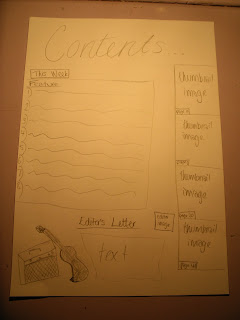After receiving all my questionnaires back I compiled the results together to make them easier to read.
Here they are:
Compiling Music Magazine Questionnaire Results
Question 1: Would you be interested in buying a music magazine?
Question 2: What type of music do you like?
Indie: 9 people People chose more than one type of music that they liked.
Rock: 6 people
Rap: 5 people
Dance: 4 people
RnB: 11 people
Pop: 9 people
Country: 2 people
Everything: 2 people
Question 3: In relation to your answer to the previous question, what would you name the music magazine?
· Inside Indie
· Beats
· Riff
· Top Pop
· Music Madness
· Tunage
· THE MUSIC MAGAZINE!
· MUSIC4U!
· Unplugged
· Madmag
· Rhythm
· RRip mUsic
· 6 people weren’t sure what to call it
Question 4: What’s the maximum you’d be willing to pay for the magazine?
Question 5: Would you prefer features on older or newer music?
Question 6: What features grab your attention?
· New and upcoming artists
· Favourable artists
· Music artist gossip
· Catchy headlines
· Attractive people on the front cover
· Bright colours
· New releases
· Interviews with celebrities
· Celeb Gossip
· Top 40
· Images
· Posters
· Funny features
· Main article/ main image
· Cover stories
· Interviews and reviews
· New singles/ albums
Question 7: What features would you particularly not be interested in?
· Old bands
· Boring ones
· Instruments
· Gossip
· Stats of music sales
· Large amounts of text
· Small pointless stories
· Advertisements
· Interviews with arrogant music artists
· Interviews
· Loads of reviews
· Info about record labels or artists managers
Question 8: Would you like the kind of language to be formal or informal?
100% chose informal and conversational.
Question 9: What would be your preferred colour scheme? (Maximum 4 colours)
· Orange, red, brown and yellow.
· Green, brown, white
· Pink
· Black, blue and white
· Orange, Pink, Black
· Red, black, white X 2
· Primary colours
· Black, Pink, White, Red
· black/white/pink/blue
· white, black, purple
· Turquoise, baby pink, baby green and yellow
· pink, white, grey
· black, white, blues and reds
· Black, pink, grey
· pink, black, white, blue
· Blue, white
· Black and Neon green
Question 10: On the front cover would you like a male or female artist/s?
Male: 6 people said this
Female: 3 people said this
Either: 5 people said this
Both: 3 people said this
Don’t mind: 1 person said this
Question 11: On the front cover would you prefer a group/band or a solo artist?
Either: 6 people said this
Group: 7 people said this
Solo Artist: 5 people said this
Question 12: What props would you like to see on the front cover with the band/solo artist?
- Guitar
- Nothing
- Microphone
- ‘bling’
- Funny or comical props
- Instruments/amps
- Things that relate to their personality
- Broomstick
Question 13: Where would you like the front cover image to have been taken?
Photography Studio: 11 said this would be better
Outdoors: 7 said this would be better
Question 14: How often would you like an issue to be published?
Monthly: 10 people suggested this
Weekly: 3 people said this
Fortnightly: 4 people suggested this
Seasonal: Only one person said this
Question 15: What freebies would you expect?
- Tokens that after a certain amount are collected amount to a free ticket to a gig.
- Offers/discounts for HMV
- None, except if they relate to that particular issue
- None
- Discounts
- Demo CD’s
- Lip Gloss and a CD
- Posters
- Headphones
- CD’s
- Nothing- maybe just a single every now and then of the cover artist
- Vouchers
- Scarf
- New Single Release
- Signed guitar pick
Question 16: Do you normally read the editors letter on the contents page? If no answer question 17.
Question 17: What would make you read the editors letter?
- If the editor was good-looking and the letter was directed entirely at people of our age and if it had information about upcoming concerts and gigs.
- Make it more obvious
- Light-hearted, chatty language
- Straight to the point, standing out, not too long and rambly
- Personal involvement/opinions
- Make it more fun, possibly a few pictures
- More humorous, less formal approach
- Interesting related information
- A picture of the editor smiling
- More interesting looking page as they normally just have black/white writing and background
- If it was short and sweet and looked appealing to read
- Attractive colours, interesting information and images
- If it had pictures
In my next blog will be my action plan that I devised after receiving this questionnaire results back.












































